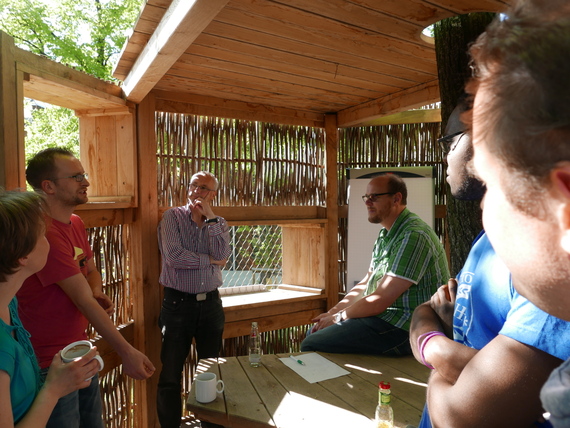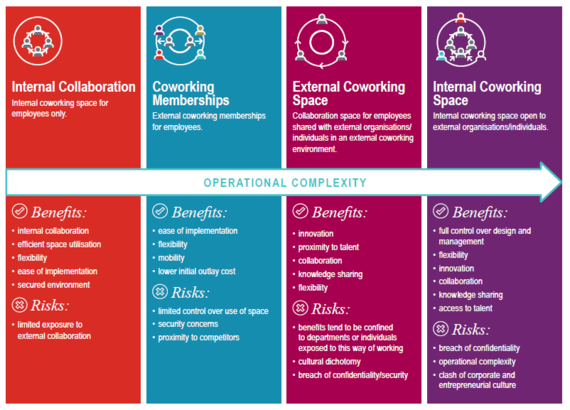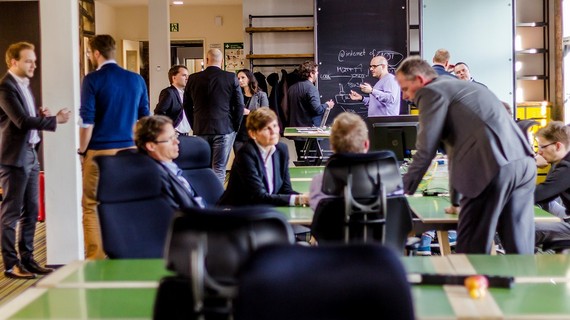Developing successful workplaces involves initiatives big and small, temporary and long-lasting. In this era of constant change, transition should be considered a structural feature of the way workplaces will be built, with a new set of tools and approaches that deal with uncertainty. Creativity, appropriation, and a rediscovery of the ability of people to shape their everyday spaces are highlighting the benefits of emergent and adaptive technologies and enable innovative business solutions.
Property value is driven by remaining relevant in the long-term which requires adaptability and dynamic user input. As advances in communication tools and cloud technology begin to render traditional office space obsolete, we need to redefine the role of office space.
Johanna Frelin, CEO of Sweden-based creative business school and consultancy Hyper Island, says we need choices. "When you work remotely, it's really important that you know the people you work with - it demands a lot of trust and requires teams to be goal, not task orientated," she says. "But increasingly, workers expect to do things when it suits them so we have to create workplaces where people actually want to go."
A sign of workers desiring in-person contact - despite technology enabling us to have less of it - is the rise in co-working spaces. According to Instant Offices 2016 Market Report, as the number of freelancers and independent workers has increased so too have the number of co-working spaces cropping up. The US Government has stated that more than 40% of the total US workforce now consists of contingent workers and this number is set to rise as working habits continue to change. The rise in consumer awareness of co-working is also reflected in the increase in Google searches, as the use of the search term "co-working" has increased by more than 400% in just five years in the US alone.
These spaces aren't just about the Wi-Fi and fresh coffee; they offer places to meet clients, a chance to expand professional networks, exchange skills, find work and in some cases have a bit of fun. Large companies are increasingly utilizing flexible co working spaces for project teams, specific business units, innovation labs, and M&A integration. More often than not these companies have established conventional offices in the same city but the provision of flexible space adds agility across the corporate structure and enables collaboration and innovation at their workplace by access to an open ecosystem of talent.
This is all fast transforming the corporate real estate landscape as a growing number of companies--large and small are eager to leverage the business benefits. In their recent Co Working Report, JLL identify the key benefits and barriers to co working and how this phenomenon is set to impact corporate real estate strategy:
Creating the appropriate flexible workplace and co working solution can be a complex place to navigate. But those that cannot keep pace with the behavioral change taking place in the workplace, spurred on by rapidly changing technology and the Internet of Things (IoT), will find themselves struggling in the battle to attract talent. Innovation starts with culture and that means focusing on people. People really care about what they do, how they work and where they work and the challenge will be to activate and localize workplace experiences and to access talent ecosystems to remain at the forefront of innovation. Accenture's Open Innovation research indicates, that in order to take advantage of burgeoning innovation and to benefit from the so-called collaboration curve, 63% of companies state the main reason for using shared office space the ability to collaborate, with 42% of companies expect collaboration with entrepreneurs, to accelerate disruptive innovation.
Twenty years after, C Base - one of the first co working spaces in the world - was set up in Berlin, Cisco have created openBerlin, possibly the most interesting new paradigm of corporate co working. The openBerlin Innovation Center, enables Cisco to lead 'co-innovation in action' and along with a vibrant ecosystem of partners, to create business and technology solutions that unlock opportunities and markets at the speed of rapid prototyping.
This is not a conventional office or co working environment. It is an open innovation center and workplace with a Think Tank, software and hardware development spaces, and demonstration areas where customers, partners, startups, academia and open developer communities can create new ideas, concepts and technologies. It also houses a micro factory, dedicated to the development of industrial 'IoT Solutions' and a tree house for collaborating close to nature.
The guiding principles are to shift innovation :
•From Years to Weeks
•From Corporate Driven to Market Driven
•From Closed to Open
The most significant additional difference is that this environment is also using big data through 3, 500 sensors, to continuously customize the user experience, to create a personalized , people centric environment. The sensors measure, keep track and remember the users preferences so when you enter any space it adjusts the set up and experience of the temperature, lighting and noise levels to your profile. The computer gets to know you and the management of the experience is based on open source to enable predictive maintenance and adjust to new ideas quickly.
Leveraging big data will certainly change the way buildings are designed and used. The Edge, a cutting-edge office building in Amsterdam by PLP Architecture, is designed to act as a social condenser and also features a seamless app and sensor system that lets workers check in with their phone and register their preferences, so the building can react and even adjust climate systems to specific user preferences.
These new types of environments , provide a model for how large corporate occupiers will position their brand and facilitate open source innovation through the workplace but also highlight the types of expectations users will have in the future.
Dave Wright, the chief strategy officer at cloud computing business Service Now says, more than anything people will begin to demand new types of predictive and immersive technology in the workplace as they use it more and more in everyday life.
"I think one of the things that will change over time is the way that people interface the technology. People joke and look around at things and think it's novel; they'll see a smartwatch or they'll see things like the Amazon Echo system and Voice Control. The reality is, these will become interconnected devices that facilitate an easier way to do work. "As people get more used to applications that they use outside of work, you'll see a trend across enterprise applications, where people have to produce things of that quality. They have to be immersive, they have to be interactive. I think we'll start to see more dynamic user interfaces."
Leveraging big data and gamification to develop self-measurement, motivation tools and access an open ecosystem of talent and innovation, will contribute to new workplace models that provide variety and choice of experiences - places and technology interfaces - to inspire and support people to do their best work and facilitate innovation and profit.



